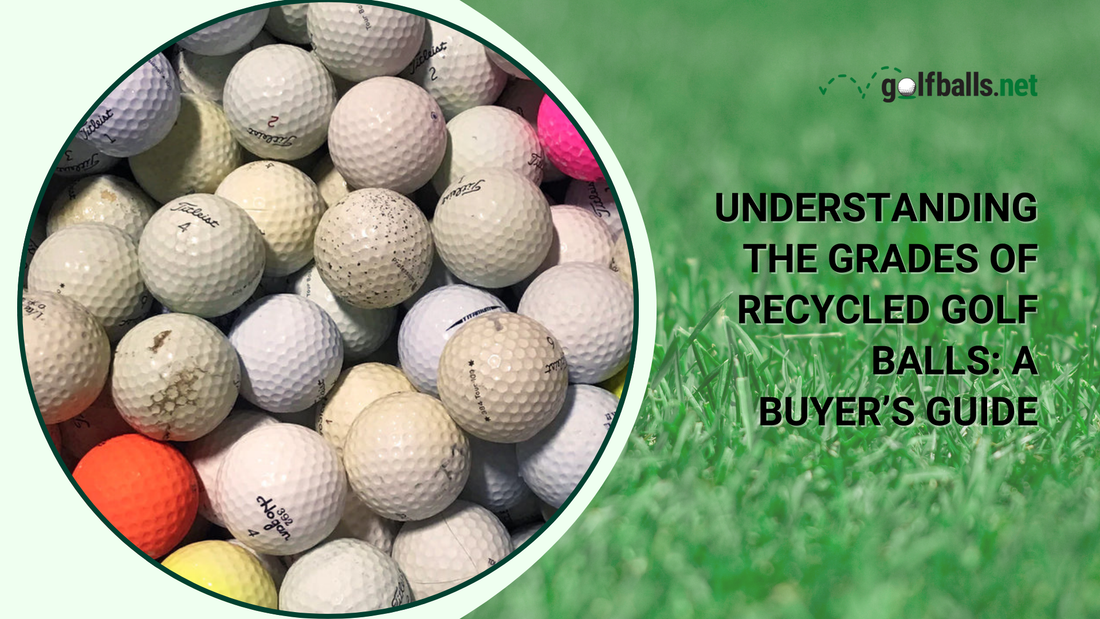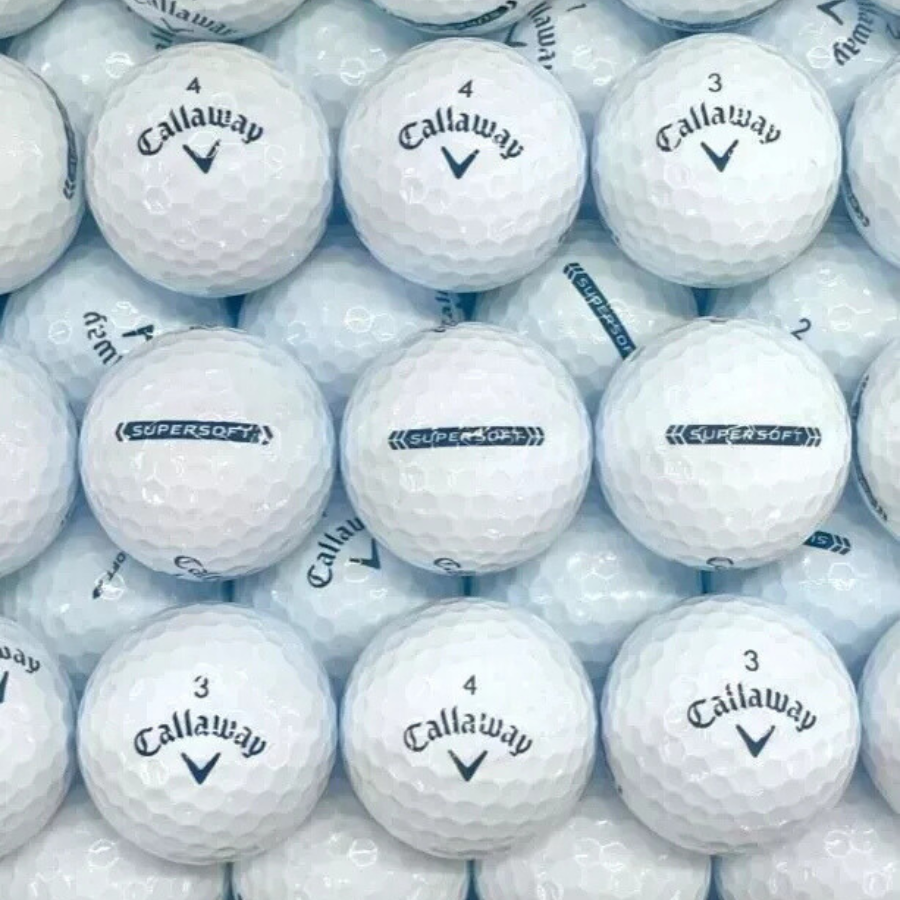
Understanding the Grades of Recycled Golf Balls: A Buyer’s Guide
Golfers today are increasingly turning to recycled golf balls as a cost-effective and eco-friendly alternative to brand-new ones. But not all used golf balls are the same. To ensure you get the quality and performance you expect, these balls are carefully graded. However, not all recycled golf balls are created equal, they undergo a meticulous grading process to ensure quality and performance. Understanding how this grading process works can help you make smarter purchasing decisions and find the perfect ball for your game. In this blog, we’ll take you through the grading process and explain what each grade means.
The Lifecycle of a Golf Ball
The journey of a golf ball doesn’t end when it lands in a water hazard or rough. Lost balls are retrieved from bunkers, woods, rough and water hazards by specialized teams who clean, inspect, and sort them for resale. This recovery process not only gives golf balls a second life but also reduces waste, contributing to a more sustainable golf industry.
Why Grading Matters for Used Golf Balls
Grading ensures that used golf balls meet certain standards of quality and performance. For golfers, this means:
• Affordable Options: Get high-quality balls without paying full price for new ones.
• Tailored Options: Allows golfers to choose balls that match their skill level and budget.
• Environmental Impact: Encourages recycling, reducing the demand for new golf balls and conserving resources.
• Quality Assurance: Ensures golfers get consistent performance from their chosen grade.
• Trust: Builds confidence in the recycled golf ball market by clearly defining quality standards.
Overview of the Grading Process
The grading process is designed to assess and sort golf balls based on their condition. Here’s how it works:
1. Collection : Golf balls are retrieved bunkers, woods, rough and water hazards along with other areas on courses.
2. Cleaning : Balls are thoroughly washed to remove dirt, grime, and debris. Specialized cleaning techniques ensure the original surface is intact.
3. Inspection : Each ball is visually examined for imperfections like player marks, scuffs, discoloration, and cracks.
4. Sorting : Based on their condition, balls are sorted into different grades to match their quality with customer expectations.
Environmental Benefits of Recycled Golf Balls
Purchasing recycled golf balls isn’t just good for your wallet, it’s also great for the planet. Recycling reduces the need to manufacture new golf balls, saving raw materials and energy. Additionally, it prevents millions of balls from ending up in landfills or waterways, helping maintain a cleaner environment for future generations.
Misconceptions About Recycled Golf Balls
1. Inferior Quality : High-grade recycled golf balls often perform as well as new ones, thanks to strict grading processes.
2. Structural Damage : Recycled balls are thoroughly inspected, with mint-grade options which appear as if almost new, down to shag balls that have large scuffs and cuts, perfect for hitting with a one and done mentality.
3. Only for Beginners : Professionals and serious golfers also use mint or near-mint recycled balls for competitive play.
4. Inconsistency : Advanced cleaning and sorting ensure consistent performance in high-grade balls.
5. Unsuitable for Serious Play : Mint-grade recycled balls are tournament-worthy and indistinguishable from new ones.
6. Refurbished Balls : Recycled balls are cleaned and unaltered, unlike refurbished balls, which are repainted.
7. Short Lifespan : High-grade recycled balls last as long as new ones when properly maintained.
Common Grading Categories for Used Golf Balls
1. Mint Grade AAAAA (5A)
• Condition: Like-new appearance with no scuffs, discoloration, or significant marks.
• Performance: Mint golf balls are as good as new balls in terms of distance, spin, and durability.
• Ideal for: Professional or serious golfers who want high performance at a lower cost.
2. Near Mint Grade AAAA (4A)
• Condition: Slight cosmetic imperfections such as minor scuffs or logos.
• Performance: Virtually identical to new balls in terms of playability.
• Ideal for: Casual players seeking a balance between quality and price.
3. Good Grade AAA (3A)
• Condition : Noticeable scuffs, small nicks, or discoloration.
• Performance : Slightly reduced performance but still functional for practice or casual rounds.
• Ideal for : Beginners or golfers on a tight budget.
4. Practice Grade
• Condition: Significant imperfections such as cuts, heavy scuffs, or faded logos.
• Performance: Not suitable for competitive play but fine for practice sessions.
• Ideal for: Driving ranges or shots where performance isn’t critical.
5. Shag Grade
• Condition : Very poor condition with cracks or severe damage.
• Performance : Unusable for rounds; best for drills or practice.
• Ideal for : Training exercises and driving ranges.
Factors Affecting Golf Ball Grades
1. Cosmetic Condition : Visible imperfections like scuffs, discoloration, and logos.
2. Core Integrity : Ensuring the internal core remains intact for optimal performance.
3. Water Damage : Prolonged submersion can degrade the core and affect aerodynamics.
4. Brand and Model : Premium brands are often graded more meticulously due to higher demand.
Tips for Choosing the Right Grade
Selecting the right grade depends on your needs:
1. Skill Level: Beginners can opt for good or practice-grade balls, while advanced players should choose mint or near-mint grades.
2. Budget: Lower grades offer more affordability for casual play.
3. Usage: Use high-grade balls for tournaments and lower-grade ones for practice.
Which Grade to Choose for Your Game
• Mint Grade: Best for advanced players who want top-tier performance.
• Near Mint Grade: Great for casual players looking for high quality at a lower price.
• Good Grade: Perfect for beginners or golfers who need practice balls.
• Practice Grade: Use for risky shots or practice where ball loss is expected.
Tips for Maintaining Recycled Golf Balls
Recycled golf balls can deliver excellent performance and durability when properly cared for. Here are some simple tips to keep them in great condition:
1. Clean Regularly
• Use warm water and a mild soap solution to remove dirt, grass stains, and debris.
• Avoid harsh chemicals that can damage the cover.
2. Store in a Cool, Dry Place
• Keep golf balls away from extreme heat or direct sunlight to prevent the cover from warping or discoloration.
• Store them in a temperature-controlled environment for optimal performance.
3. Inspect Before Play
• Check for scuffs, cracks, or other damage before using the ball.
• Retire balls with noticeable wear to practice sessions.
4. Rotate Usage
• Use multiple balls in your games to distribute wear and tear evenly.
• This helps prolong the lifespan of each ball.
5. Avoid Harsh Surfaces
• Refrain from hitting balls off cart paths, rocky areas, or hard surfaces.
• Use soft tees and smooth greens whenever possible.
6. Use a Golf Towel
• Wipe your ball after every shot to keep it free from dirt and maintain accuracy.
• Clean balls fly straighter and roll better on the greens.
Conclusion
Understanding how used golf balls are graded can help you make informed decisions and find the right balance between cost and performance. Whether you’re a professional golfer or a beginner, there’s a grade to match your needs.
Looking for top-quality recycled golf balls? Explore our collection of premium used golf balls today at Golfballs.net and find the perfect match for your next round!

